Overview
The article examines the significant advantages of semiconductor cooling fans for electronics engineers, highlighting their critical role in improving thermal management, reliability, energy efficiency, and overall system performance. By illustrating how effective temperature regulation mitigates overheating, prolongs the lifespan of components, reduces operational costs, and ensures adherence to industry standards, it underscores the necessity of these cooling solutions in contemporary electronic designs.
Introduction
Semiconductor cooling fans are increasingly vital in the electronics sector, where efficient thermal management can significantly impact optimal performance and prevent catastrophic failure.
With the rising demand for high-performance computing and energy-efficient technologies, it is essential for electronics engineers to comprehend the myriad benefits these fans provide.
However, engineers face several challenges when integrating these cooling solutions.
Understanding how to leverage the advantages of semiconductor cooling fans can enhance reliability, efficiency, and compliance in their designs, ultimately leading to superior performance.
Gagner-Toomey Associates: Leading Provider of Semiconductor Cooling Solutions
Gagner-Toomey Associates stands out as a leading provider of semiconductor cooling fans, effectively addressing the specific challenges faced by electronics engineers through advanced temperature management technologies. The firm collaborates with a diverse array of exceptional manufacturers to deliver state-of-the-art temperature control solutions that significantly enhance the efficiency and reliability of electronic devices.
With the semiconductor cooling fan market anticipated to expand at a from 2025 to 2033—driven by the escalating demand for high-performance computing and energy-efficient technologies—Gagner-Toomey is strategically positioned to fulfill these evolving requirements. Their steadfast commitment to excellence is reflected not only in their innovative product offerings but also in their outstanding customer service, solidifying their status as a trusted partner within the electronics sector.
Successful implementations of their semiconductor cooling fan technologies have demonstrated considerable benefits, including improved thermal management and reduced energy consumption—crucial factors for the advancement of modern systems.
![]()
Improved Thermal Management: Essential for Electronics Performance
Semiconductor cooling fans play a pivotal role in enhancing thermal regulation within technological systems. By facilitating efficient heat dissipation, semiconductor cooling fans ensure optimal operating temperatures, which are essential for the performance and longevity of components.
As we look towards 2025, the average operating temperature for many devices is projected to stabilize around 40°C, with maximum allowable temperatures soaring up to 80°C. Notably, the overall temperature of devices can peak at 65.84°C, underscoring the critical need for effective temperature regulation strategies.
Efficient thermal management, often achieved with a semiconductor cooling fan, not only averts overheating but also mitigates the risk of component failure, which is responsible for approximately 55% of electronic equipment failures. This proactive approach guarantees that devices function at peak efficiency.
For instance, the integration of ventilation devices in high-performance computing systems has yielded significant improvements in thermal management, allowing for increased transistor counts and reduced heat flux density. Furthermore, a hybrid temperature control technique that combines spray and immersion methods has demonstrated an impressive enhancement in heat flux by up to 65.6%, illustrating the tangible benefits of air circulation devices.
Ultimately, this leads to improved , establishing semiconductor cooling fans as an indispensable element in modern design.
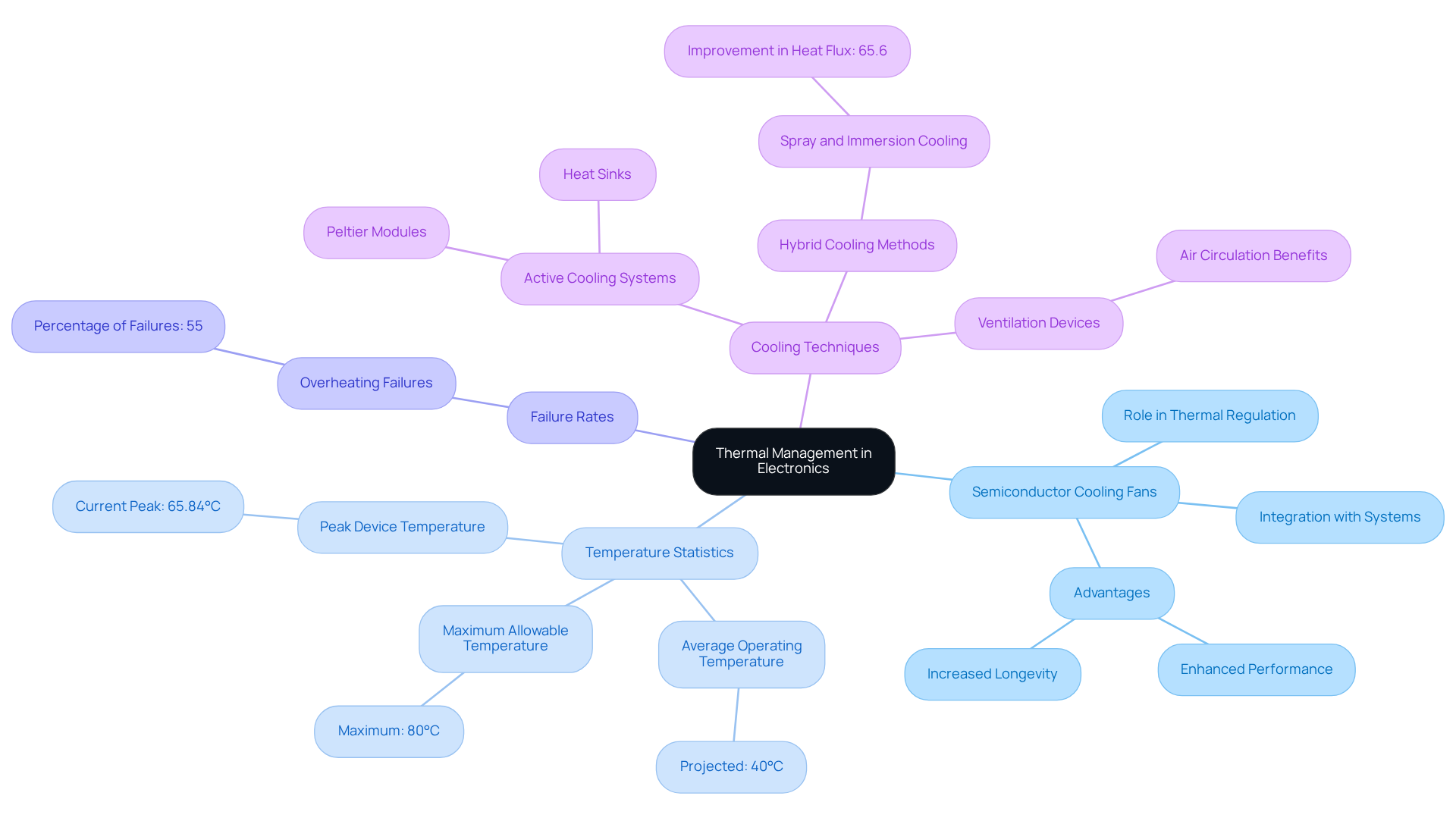
Increased Reliability: Extending the Lifespan of Electronic Components
A semiconductor cooling fan is essential for enhancing the reliability of electrical components by effectively managing heat and minimizing thermal stress. Excessive heat can precipitate immediate catastrophic failures or gradual degradation of components, significantly diminishing their lifespan. Devices equipped with advanced temperature management systems experience reduced thermal strain and demonstrate extended operational durations.
As noted by United Resin, maintaining safe temperature ranges through efficient thermal management is critical to preventing failures and prolonging the lifespan of devices. By 2025, components utilizing Gagner-Toomey’s cutting-edge temperature management solutions, particularly the semiconductor cooling fan, are expected to surpass 38,400 hours of typical lifespan, underscoring the vital importance of integrating semiconductor temperature regulation devices into device designs.
Moreover, can lead to reduced maintenance costs, resulting in fewer replacements and enhanced reliability, particularly in high-stakes applications where downtime can incur substantial financial losses.
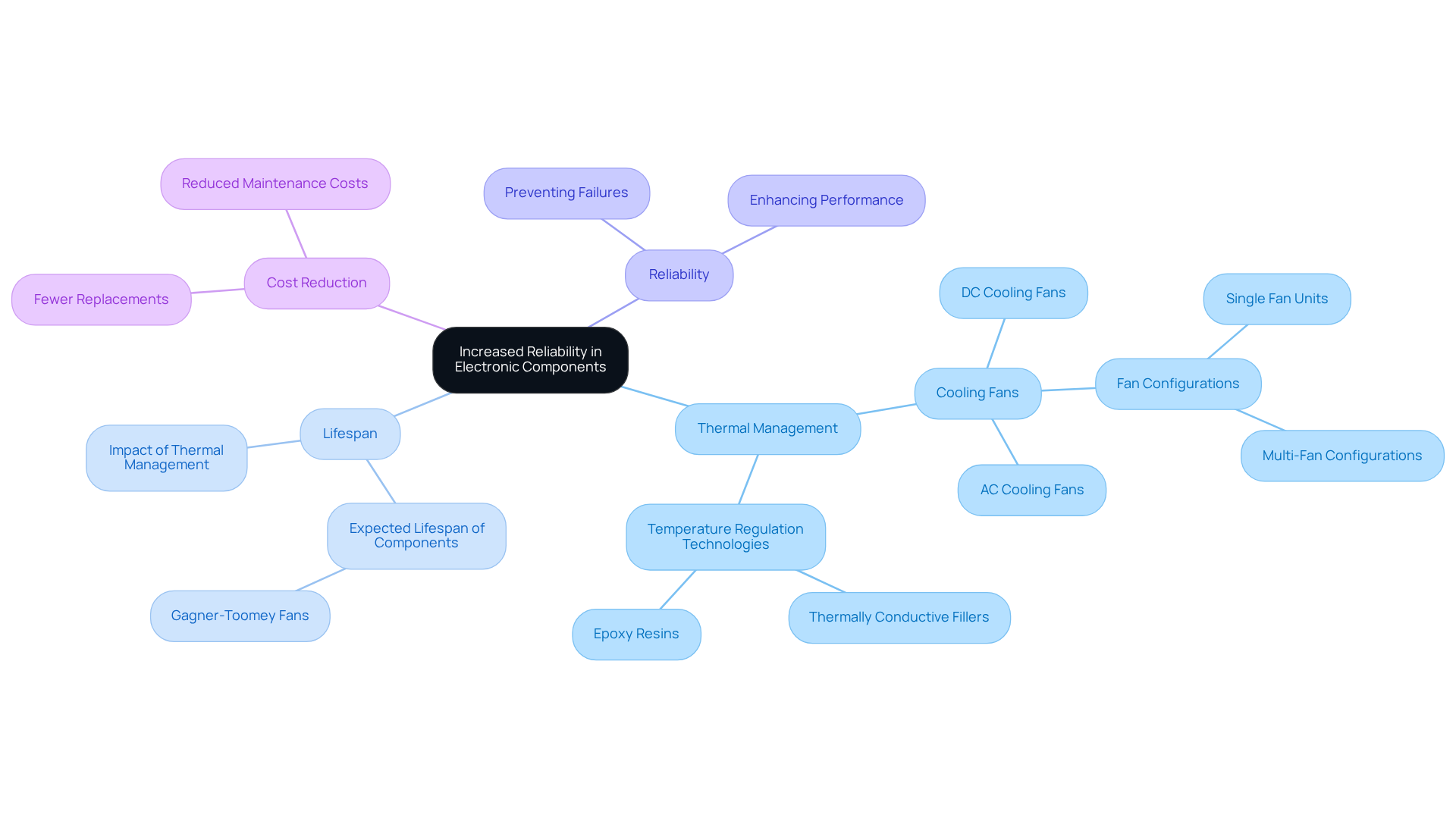
Energy Efficiency: Reducing Power Consumption in Electronics
Semiconductor cooling fans are meticulously engineered with as a primary focus, significantly aiding in the reduction of total power usage within electronic systems. By optimizing airflow and minimizing energy waste, these devices not only help decrease operational costs but also lessen the environmental impact. Engineers have the flexibility to select devices that operate at varying speeds, thereby enhancing energy efficiency during periods of low demand while still ensuring adequate temperature regulation when necessary.
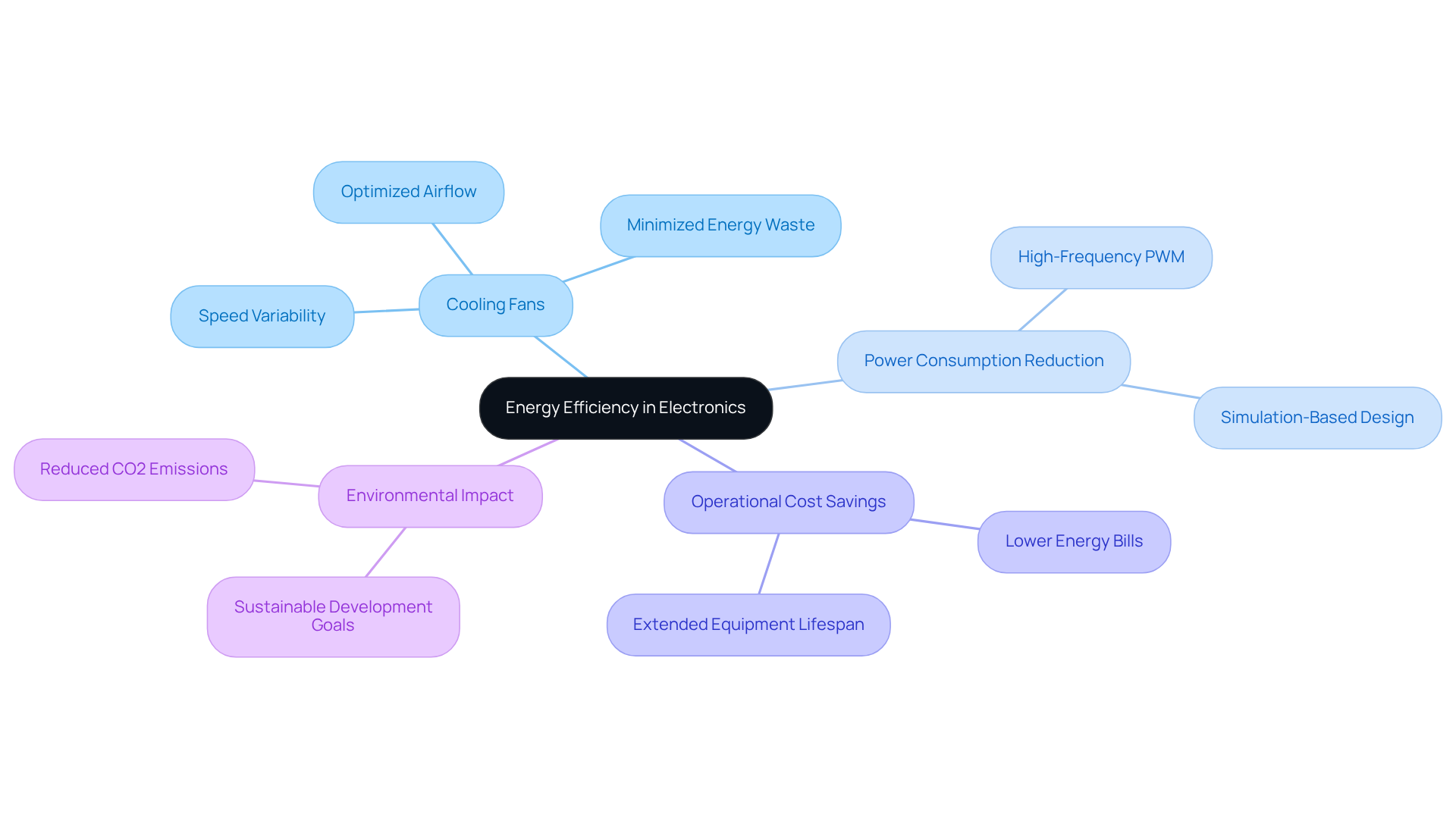
Noise Reduction: Enhancing User Experience in Electronics
Semiconductor cooling fans play a pivotal role in enhancing user experience by operating silently, a feature that significantly benefits electronic devices. By leveraging advanced designs and materials, these systems utilize a semiconductor cooling fan to achieve low noise levels while ensuring effective cooling performance. This characteristic is vital in consumer electronics, where can detract from usability and overall satisfaction.
Engineers have the option to utilize semiconductor cooling fans that are equipped with noise-reduction technologies, fostering a more enjoyable operating environment. For example, the integration of brushless DC motors alongside innovative blade designs has resulted in quieter semiconductor cooling fan solutions, allowing devices to operate seamlessly without disruptive sound.
As the demand for quieter electronics escalates, manufacturers are increasingly prioritizing the reduction of noise from the semiconductor cooling fan to enhance user experience. Furthermore, user research is indispensable for understanding the needs and desires of end users, underscoring the importance of user-centered design in fan technology.
The ongoing trend of miniaturization in devices further amplifies the demand for compact, high-efficiency cooling systems, particularly semiconductor cooling fans, making quiet operation a crucial factor in the realm of modern electronics.
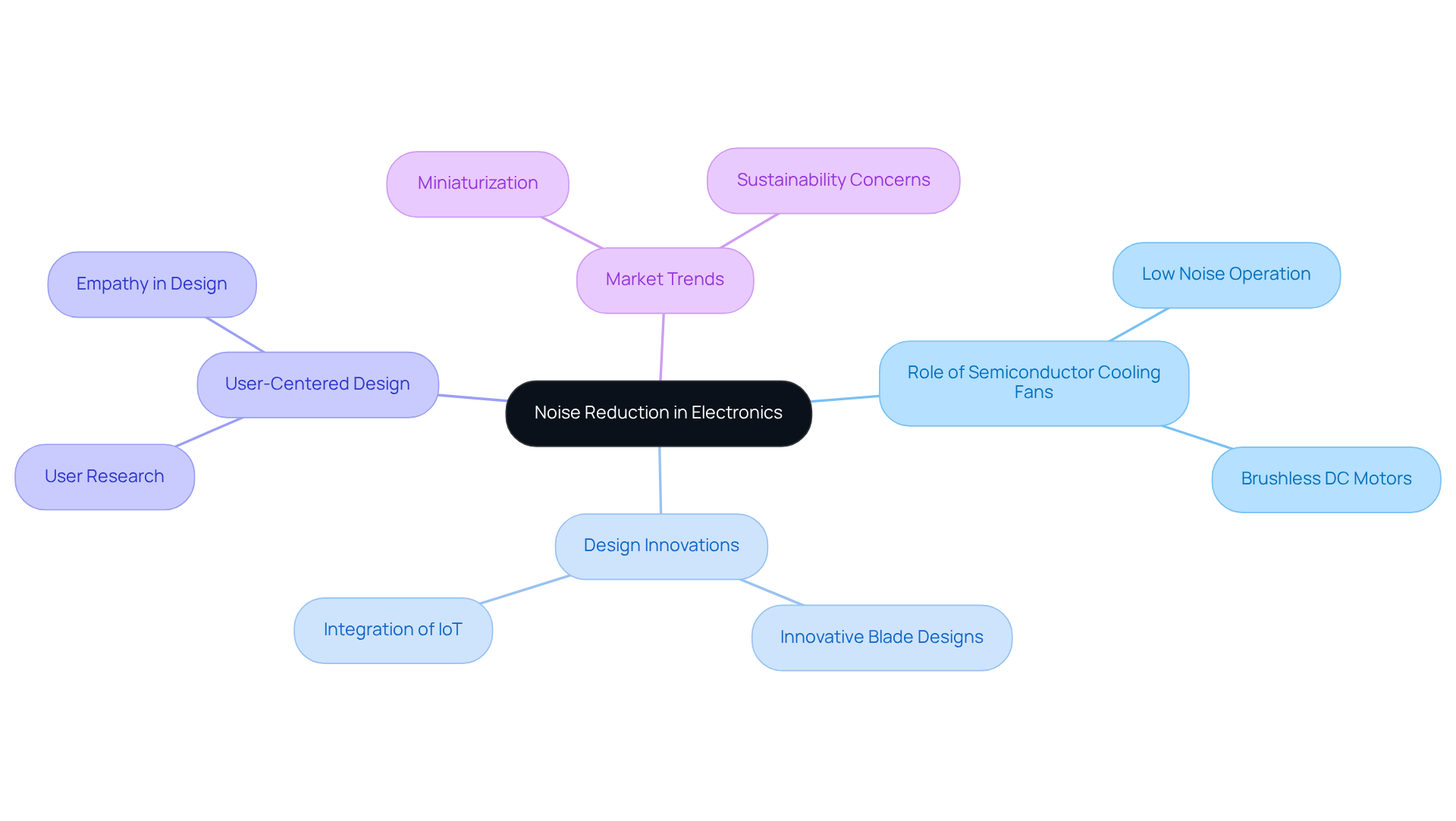
Versatility: Adapting to Diverse Electronics Applications
Semiconductor cooling fans exhibit remarkable versatility, making them suitable for a wide range of electronic applications, from consumer devices to industrial machinery. Their compact design facilitates effective temperature regulation in confined spaces, a critical requirement for modern electronics that require a semiconductor cooling fan for efficient thermal management. Engineers can leverage this adaptability to devise tailored temperature regulation strategies that align with specific project needs, ultimately enhancing overall system performance.
Notably, the automotive sector stands as the fastest-growing consumer of ventilation devices, driven by the demands of electric vehicles. This surge has created a pressing need for advanced thermal management techniques that enhance battery longevity through predictive temperature control technologies.
Furthermore, the integration of AI-driven cooling systems in data centers exemplifies how these devices can dynamically adjust to fluctuating thermal loads, ensuring optimal performance while minimizing energy consumption.
As the market for temperature regulation devices is projected to expand significantly, nearing approximately USD 22.83 billion by 2034 with a CAGR of 3.95% from 2025 to 2034, the demand for customized thermal management solutions will inevitably increase. This underscores the critical in systems that utilize a semiconductor cooling fan for temperature regulation.
Moreover, axial blowers dominate the market due to their effective airflow configuration and versatility across various applications, underscoring their vital role in the evolving landscape of electronics temperature management.
![]()
Cost-Effectiveness: Maximizing Value in Electronics Design
Investing in semiconductor temperature regulation devices presents a compelling economic strategy for electronics engineers. These significantly improve thermal management, thereby enhancing the reliability of electronic systems. Over time, this results in considerable savings in maintenance and replacement costs.
For instance, energy-efficient refrigeration methods can reduce utility expenses by as much as 70% compared to traditional air conditioning systems, thereby increasing the overall value of the investment. Furthermore, the substantial market for semiconductor cooling fans is projected to grow from $7.72 billion in 2024 to $13.79 billion in 2029, reflecting a CAGR of 13.3%, underscoring the escalating demand for effective temperature regulation.
Engineers should also consider specific instances of long-term savings, such as diminished operational costs in data centers and telecommunications, when evaluating these temperature management solutions. Additionally, routine maintenance is crucial for sustaining the efficiency and longevity of temperature control systems, ensuring they deliver optimal performance consistently.
By meticulously assessing the long-term financial benefits of these temperature control solutions against their initial costs, engineers can make informed design decisions that align with both performance and budgetary considerations. The integration of advanced temperature management technologies not only bolsters operational efficiency but also fosters sustainable practices in electronics design, ultimately benefiting both the environment and the bottom line.
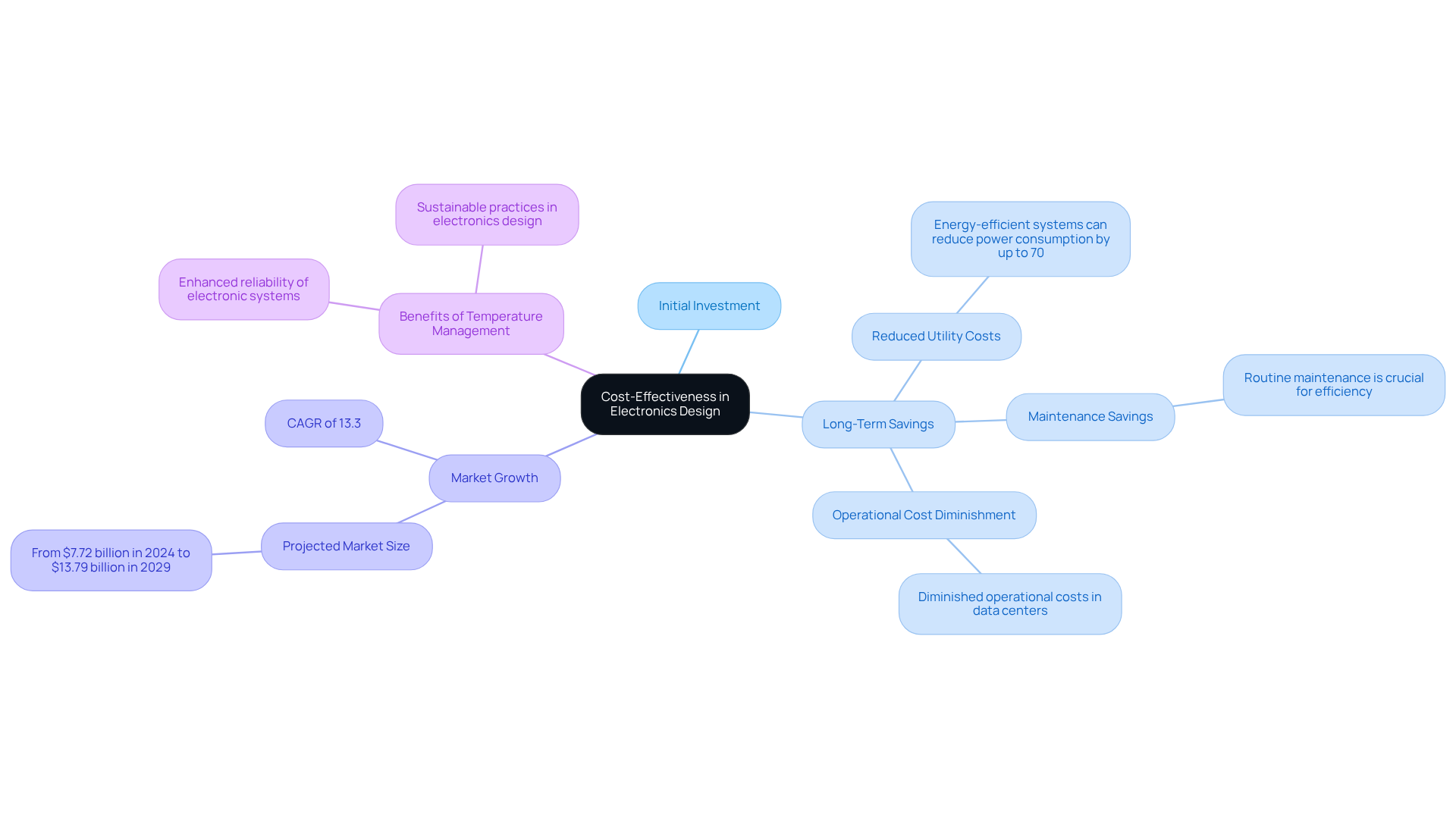
Ease of Integration: Streamlining Electronics Design Processes
Semiconductor airflow devices are engineered for seamless integration into a variety of electronic systems, significantly simplifying the design process for engineers. Their compact dimensions and versatile mounting options facilitate straightforward installation across diverse applications. This not only minimizes design complexity but also accelerates time-to-market, allowing engineers to focus on other critical project elements while ensuring effective thermal management.
As the demand for efficient temperature control escalates, the ability to swiftly deploy these devices becomes increasingly vital in meeting project timelines and enhancing overall efficiency. For example, the integration of brushless fan technology can substantially reduce installation time and errors, enabling engineers to optimize designs without the encumbrance of extensive setup procedures.
Furthermore, brushless devices can operate for over 50,000 hours, which lowers maintenance costs and further boosts project efficiency. The projected growth of the fan market from USD 15.50 billion in 2024 to USD 22.83 billion by 2034 underscores the importance of adopting these advanced solutions.
Additionally, the synergy of IoT with temperature control devices facilitates real-time monitoring and intelligent management, addressing the evolving needs of electronics engineers. By considering the integration of brushless devices in future projects, engineers can enhance efficiency and mitigate design complexity, establishing these solutions as essential in navigating the complexities of modern electronics development.
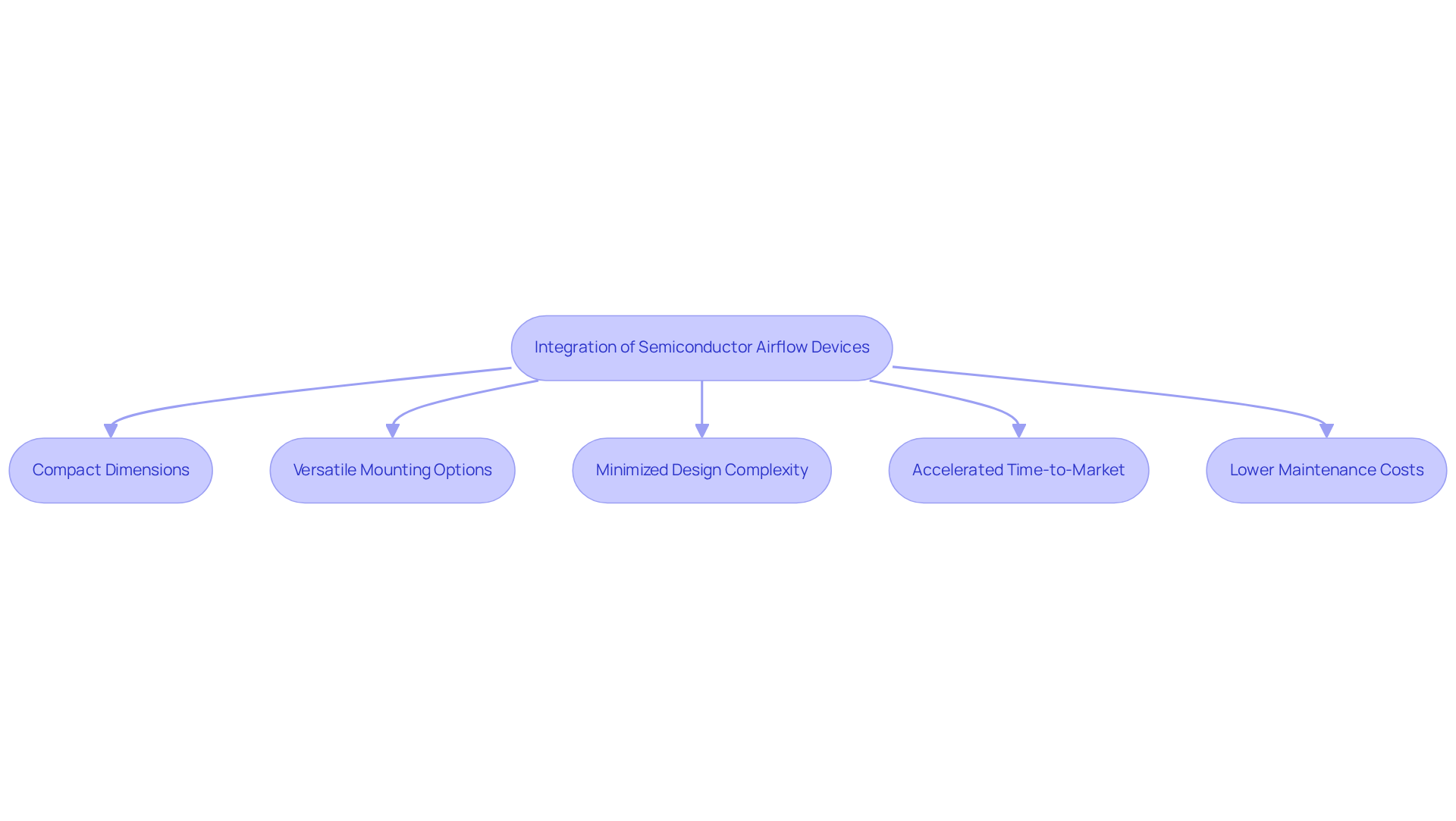
Performance Optimization: Enhancing System Efficiency
The implementation of semiconductor cooling fans significantly enhances the efficiency of electronic systems. By ensuring optimal operating temperatures, the semiconductor cooling fan prevents thermal throttling, thereby enabling components to perform at their maximum potential. This optimization is essential in high-demand scenarios, where every fraction of is vital. Engineers can leverage advanced temperature regulation techniques to elevate the overall performance of their designs, ultimately driving innovation and reliability in their applications.
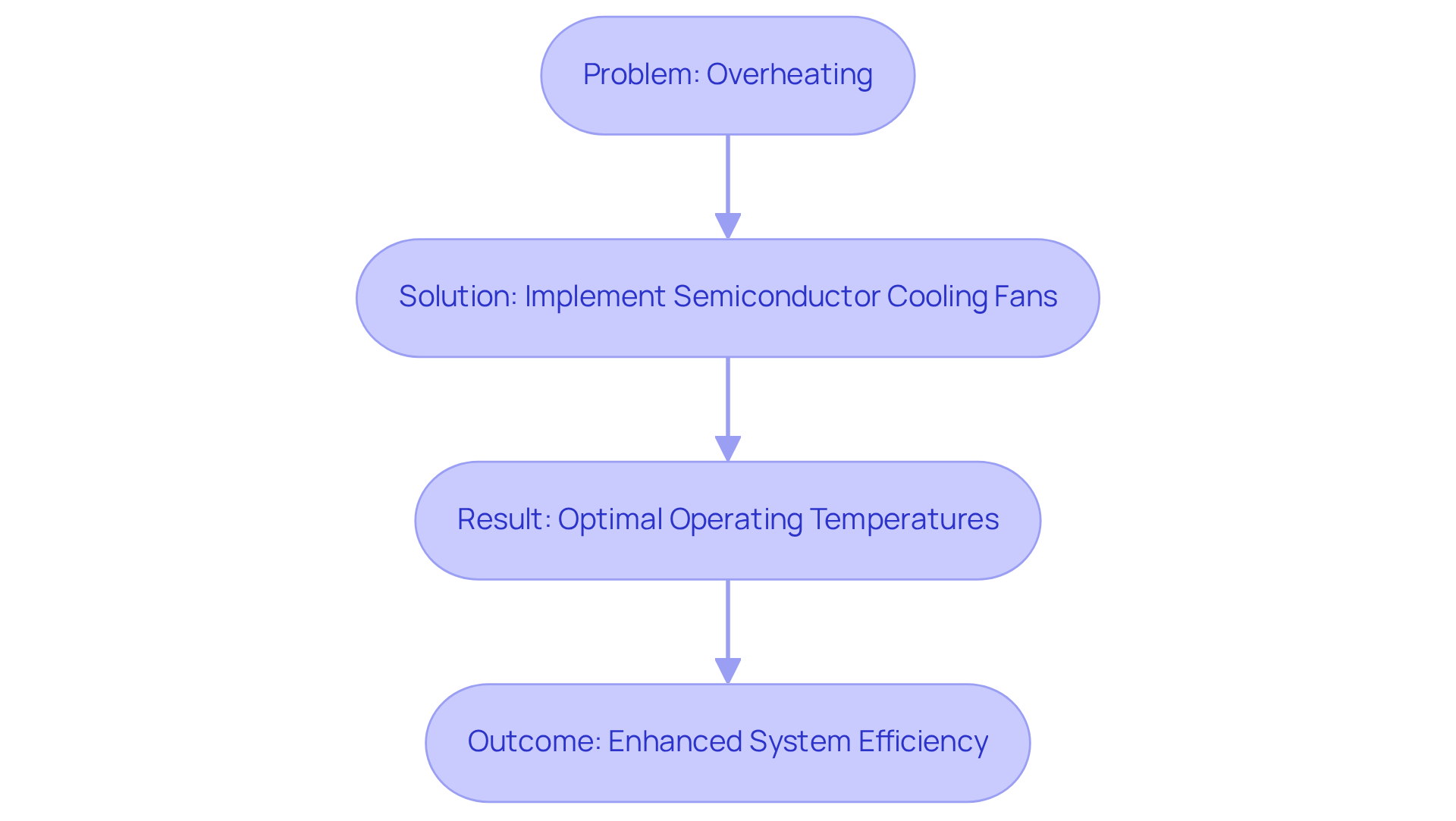
Regulatory Compliance: Meeting Industry Standards with Cooling Solutions
Incorporating semiconductor cooling fans into electronic designs is essential for engineers aiming to achieve regulatory compliance standards. Effective thermal management transcends mere performance enhancement; it often serves as a prerequisite for certifications related to safety and operational efficiency.
By employing temperature control methods that align with industry standards, such as those compliant with Automotive Standard SAE and VDA, engineers can ensure their products excel in performance while adhering to necessary regulations. This proactive approach streamlines market entry and mitigates the risk of , which can lead to significant delays.
Statistics indicate that non-compliance in the electronics sector can result in market entry delays of up to 30%, underscoring the critical nature of effective thermal management. Creative strategies, including solenoid and rotary boost pumps, can further enhance temperature regulation and compliance.
As industry experts assert, ‘Quality is never an accident; it is always the result of high intention, sincere effort, intelligent direction, and skillful execution.’ By prioritizing semiconductor cooling fan solutions, engineers can effectively navigate the complexities of compliance and enhance their product offerings.
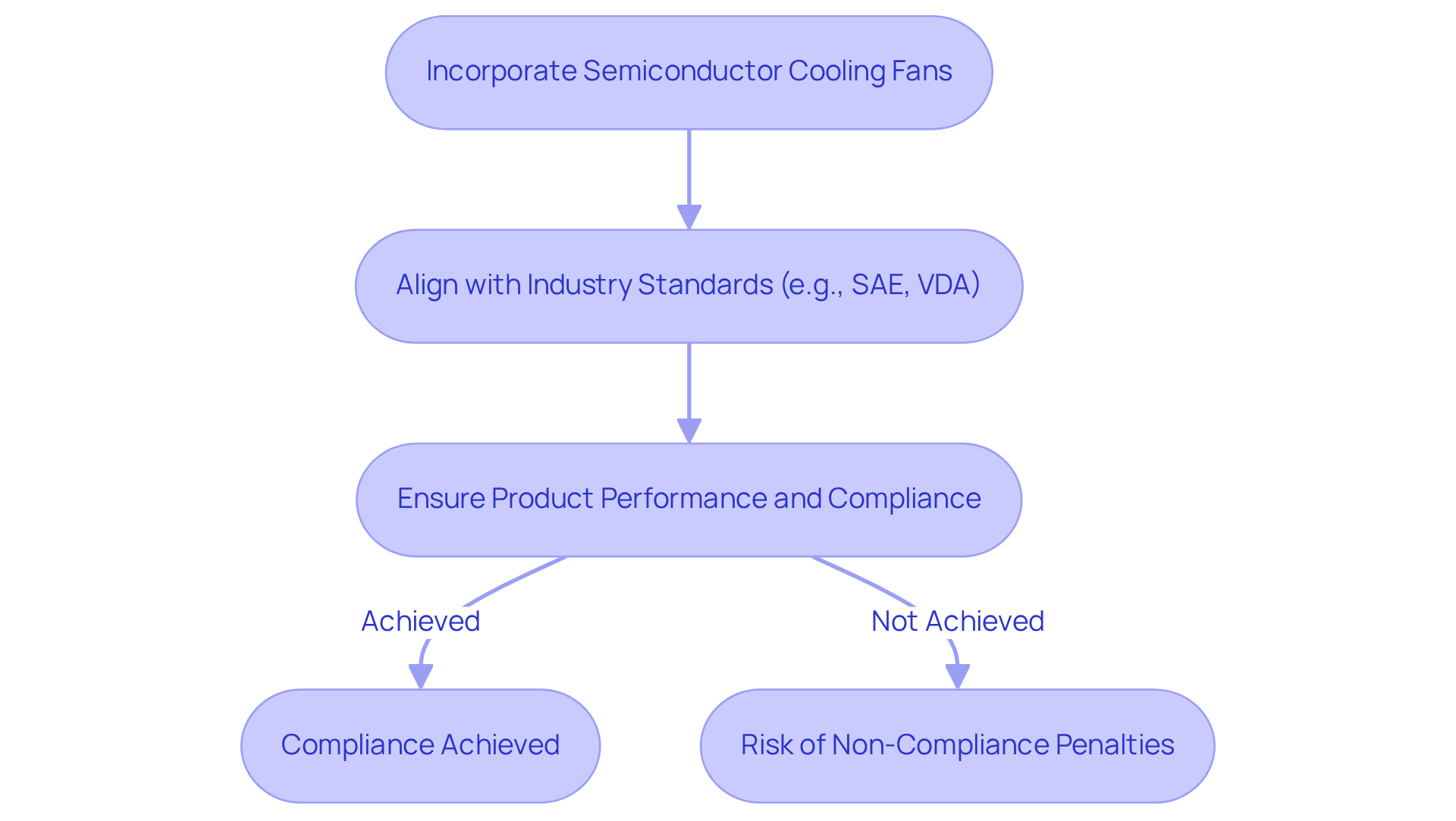
Conclusion
The significance of semiconductor cooling fans is paramount in enhancing the performance, reliability, and efficiency of electronic systems. These advanced cooling solutions are indispensable for managing heat, preventing component failure, and ensuring optimal device operation across various applications. By integrating semiconductor cooling fans, electronics engineers can profoundly enhance device longevity and user experience while addressing the escalating demands for energy efficiency and regulatory compliance.
Key benefits have been highlighted throughout the article, including:
- Improved thermal management
- Increased reliability
- Energy efficiency
- Noise reduction
- Versatility across applications
- Cost-effectiveness
- Ease of integration
- Performance optimization
- Adherence to industry regulations
Each of these factors contributes to the overarching goal of achieving superior electronic performance and sustainability, establishing semiconductor cooling fans as critical components in modern electronics design.
As the electronics landscape continues to evolve, the necessity of effective thermal management strategies becomes increasingly evident. Engineers are urged to embrace innovative cooling solutions to not only meet performance standards but also to promote sustainable practices within the industry. By prioritizing the integration of semiconductor cooling fans, professionals can spearhead advancements in technology while ensuring their designs are both efficient and compliant with essential regulations.
Frequently Asked Questions
What is Gagner-Toomey Associates known for?
Gagner-Toomey Associates is recognized as a leading provider of semiconductor cooling fans, addressing challenges faced by electronics engineers through advanced temperature management technologies.
What market trends are influencing Gagner-Toomey Associates?
The semiconductor cooling fan market is expected to grow at a CAGR of approximately 6.40% from 2025 to 2033, driven by the rising demand for high-performance computing and energy-efficient technologies.
How does Gagner-Toomey ensure product excellence?
Gagner-Toomey collaborates with various exceptional manufacturers to deliver innovative temperature control solutions, complemented by outstanding customer service.
What benefits do semiconductor cooling fans provide?
Semiconductor cooling fans improve thermal management and reduce energy consumption, which are crucial for enhancing the efficiency and reliability of electronic devices.
Why is thermal management important for electronics?
Effective thermal management prevents overheating and mitigates the risk of component failure, which accounts for approximately 55% of electronic equipment failures, ensuring devices operate at peak efficiency.
What are the projected operating temperatures for devices by 2025?
The average operating temperature for many devices is projected to stabilize around 40°C, with maximum allowable temperatures reaching up to 80°C, and peak temperatures around 65.84°C.
How do semiconductor cooling fans affect the lifespan of electronic components?
By effectively managing heat and minimizing thermal stress, semiconductor cooling fans help extend the operational lifespan of components, which is expected to exceed 38,400 hours with Gagner-Toomey’s solutions by 2025.
What financial benefits can effective thermal management provide?
Effective thermal management can lead to reduced maintenance costs, fewer replacements, and enhanced reliability, particularly in high-stakes applications where downtime can incur significant financial losses.
